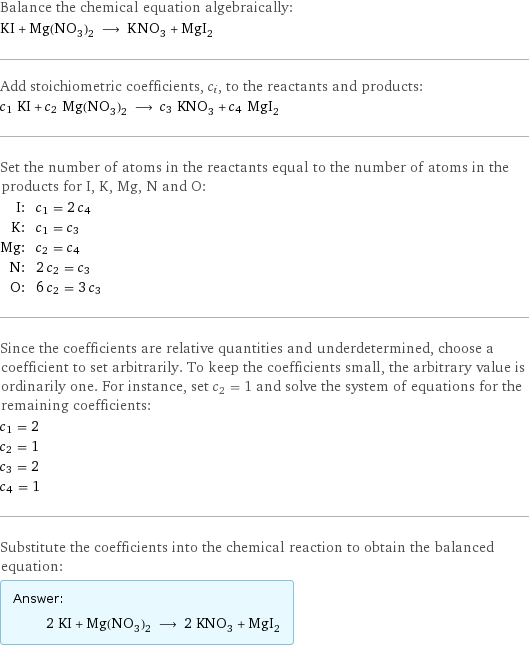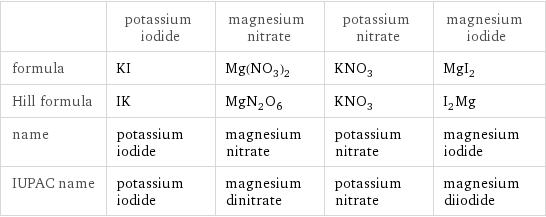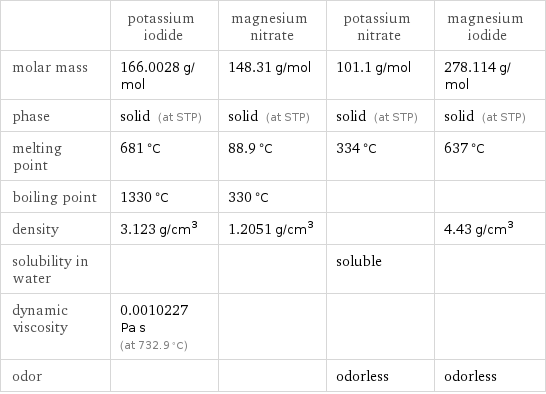Input interpretation

KI potassium iodide + Mg(NO_3)_2 magnesium nitrate ⟶ KNO_3 potassium nitrate + MgI_2 magnesium iodide
Balanced equation

Balance the chemical equation algebraically: KI + Mg(NO_3)_2 ⟶ KNO_3 + MgI_2 Add stoichiometric coefficients, c_i, to the reactants and products: c_1 KI + c_2 Mg(NO_3)_2 ⟶ c_3 KNO_3 + c_4 MgI_2 Set the number of atoms in the reactants equal to the number of atoms in the products for I, K, Mg, N and O: I: | c_1 = 2 c_4 K: | c_1 = c_3 Mg: | c_2 = c_4 N: | 2 c_2 = c_3 O: | 6 c_2 = 3 c_3 Since the coefficients are relative quantities and underdetermined, choose a coefficient to set arbitrarily. To keep the coefficients small, the arbitrary value is ordinarily one. For instance, set c_2 = 1 and solve the system of equations for the remaining coefficients: c_1 = 2 c_2 = 1 c_3 = 2 c_4 = 1 Substitute the coefficients into the chemical reaction to obtain the balanced equation: Answer: | | 2 KI + Mg(NO_3)_2 ⟶ 2 KNO_3 + MgI_2
Structures

+ ⟶ +
Names

potassium iodide + magnesium nitrate ⟶ potassium nitrate + magnesium iodide
Equilibrium constant
![Construct the equilibrium constant, K, expression for: KI + Mg(NO_3)_2 ⟶ KNO_3 + MgI_2 Plan: • Balance the chemical equation. • Determine the stoichiometric numbers. • Assemble the activity expression for each chemical species. • Use the activity expressions to build the equilibrium constant expression. Write the balanced chemical equation: 2 KI + Mg(NO_3)_2 ⟶ 2 KNO_3 + MgI_2 Assign stoichiometric numbers, ν_i, using the stoichiometric coefficients, c_i, from the balanced chemical equation in the following manner: ν_i = -c_i for reactants and ν_i = c_i for products: chemical species | c_i | ν_i KI | 2 | -2 Mg(NO_3)_2 | 1 | -1 KNO_3 | 2 | 2 MgI_2 | 1 | 1 Assemble the activity expressions accounting for the state of matter and ν_i: chemical species | c_i | ν_i | activity expression KI | 2 | -2 | ([KI])^(-2) Mg(NO_3)_2 | 1 | -1 | ([Mg(NO3)2])^(-1) KNO_3 | 2 | 2 | ([KNO3])^2 MgI_2 | 1 | 1 | [MgI2] The equilibrium constant symbol in the concentration basis is: K_c Mulitply the activity expressions to arrive at the K_c expression: Answer: | | K_c = ([KI])^(-2) ([Mg(NO3)2])^(-1) ([KNO3])^2 [MgI2] = (([KNO3])^2 [MgI2])/(([KI])^2 [Mg(NO3)2])](../image_source/a47302e56304363687e8517c92a279e8.png)
Construct the equilibrium constant, K, expression for: KI + Mg(NO_3)_2 ⟶ KNO_3 + MgI_2 Plan: • Balance the chemical equation. • Determine the stoichiometric numbers. • Assemble the activity expression for each chemical species. • Use the activity expressions to build the equilibrium constant expression. Write the balanced chemical equation: 2 KI + Mg(NO_3)_2 ⟶ 2 KNO_3 + MgI_2 Assign stoichiometric numbers, ν_i, using the stoichiometric coefficients, c_i, from the balanced chemical equation in the following manner: ν_i = -c_i for reactants and ν_i = c_i for products: chemical species | c_i | ν_i KI | 2 | -2 Mg(NO_3)_2 | 1 | -1 KNO_3 | 2 | 2 MgI_2 | 1 | 1 Assemble the activity expressions accounting for the state of matter and ν_i: chemical species | c_i | ν_i | activity expression KI | 2 | -2 | ([KI])^(-2) Mg(NO_3)_2 | 1 | -1 | ([Mg(NO3)2])^(-1) KNO_3 | 2 | 2 | ([KNO3])^2 MgI_2 | 1 | 1 | [MgI2] The equilibrium constant symbol in the concentration basis is: K_c Mulitply the activity expressions to arrive at the K_c expression: Answer: | | K_c = ([KI])^(-2) ([Mg(NO3)2])^(-1) ([KNO3])^2 [MgI2] = (([KNO3])^2 [MgI2])/(([KI])^2 [Mg(NO3)2])
Rate of reaction
![Construct the rate of reaction expression for: KI + Mg(NO_3)_2 ⟶ KNO_3 + MgI_2 Plan: • Balance the chemical equation. • Determine the stoichiometric numbers. • Assemble the rate term for each chemical species. • Write the rate of reaction expression. Write the balanced chemical equation: 2 KI + Mg(NO_3)_2 ⟶ 2 KNO_3 + MgI_2 Assign stoichiometric numbers, ν_i, using the stoichiometric coefficients, c_i, from the balanced chemical equation in the following manner: ν_i = -c_i for reactants and ν_i = c_i for products: chemical species | c_i | ν_i KI | 2 | -2 Mg(NO_3)_2 | 1 | -1 KNO_3 | 2 | 2 MgI_2 | 1 | 1 The rate term for each chemical species, B_i, is 1/ν_i(Δ[B_i])/(Δt) where [B_i] is the amount concentration and t is time: chemical species | c_i | ν_i | rate term KI | 2 | -2 | -1/2 (Δ[KI])/(Δt) Mg(NO_3)_2 | 1 | -1 | -(Δ[Mg(NO3)2])/(Δt) KNO_3 | 2 | 2 | 1/2 (Δ[KNO3])/(Δt) MgI_2 | 1 | 1 | (Δ[MgI2])/(Δt) (for infinitesimal rate of change, replace Δ with d) Set the rate terms equal to each other to arrive at the rate expression: Answer: | | rate = -1/2 (Δ[KI])/(Δt) = -(Δ[Mg(NO3)2])/(Δt) = 1/2 (Δ[KNO3])/(Δt) = (Δ[MgI2])/(Δt) (assuming constant volume and no accumulation of intermediates or side products)](../image_source/3cdeb2c5a5b2f4adad4a2e28ed875ba3.png)
Construct the rate of reaction expression for: KI + Mg(NO_3)_2 ⟶ KNO_3 + MgI_2 Plan: • Balance the chemical equation. • Determine the stoichiometric numbers. • Assemble the rate term for each chemical species. • Write the rate of reaction expression. Write the balanced chemical equation: 2 KI + Mg(NO_3)_2 ⟶ 2 KNO_3 + MgI_2 Assign stoichiometric numbers, ν_i, using the stoichiometric coefficients, c_i, from the balanced chemical equation in the following manner: ν_i = -c_i for reactants and ν_i = c_i for products: chemical species | c_i | ν_i KI | 2 | -2 Mg(NO_3)_2 | 1 | -1 KNO_3 | 2 | 2 MgI_2 | 1 | 1 The rate term for each chemical species, B_i, is 1/ν_i(Δ[B_i])/(Δt) where [B_i] is the amount concentration and t is time: chemical species | c_i | ν_i | rate term KI | 2 | -2 | -1/2 (Δ[KI])/(Δt) Mg(NO_3)_2 | 1 | -1 | -(Δ[Mg(NO3)2])/(Δt) KNO_3 | 2 | 2 | 1/2 (Δ[KNO3])/(Δt) MgI_2 | 1 | 1 | (Δ[MgI2])/(Δt) (for infinitesimal rate of change, replace Δ with d) Set the rate terms equal to each other to arrive at the rate expression: Answer: | | rate = -1/2 (Δ[KI])/(Δt) = -(Δ[Mg(NO3)2])/(Δt) = 1/2 (Δ[KNO3])/(Δt) = (Δ[MgI2])/(Δt) (assuming constant volume and no accumulation of intermediates or side products)
Chemical names and formulas

| potassium iodide | magnesium nitrate | potassium nitrate | magnesium iodide formula | KI | Mg(NO_3)_2 | KNO_3 | MgI_2 Hill formula | IK | MgN_2O_6 | KNO_3 | I_2Mg name | potassium iodide | magnesium nitrate | potassium nitrate | magnesium iodide IUPAC name | potassium iodide | magnesium dinitrate | potassium nitrate | magnesium diiodide
Substance properties

| potassium iodide | magnesium nitrate | potassium nitrate | magnesium iodide molar mass | 166.0028 g/mol | 148.31 g/mol | 101.1 g/mol | 278.114 g/mol phase | solid (at STP) | solid (at STP) | solid (at STP) | solid (at STP) melting point | 681 °C | 88.9 °C | 334 °C | 637 °C boiling point | 1330 °C | 330 °C | | density | 3.123 g/cm^3 | 1.2051 g/cm^3 | | 4.43 g/cm^3 solubility in water | | | soluble | dynamic viscosity | 0.0010227 Pa s (at 732.9 °C) | | | odor | | | odorless | odorless
Units
